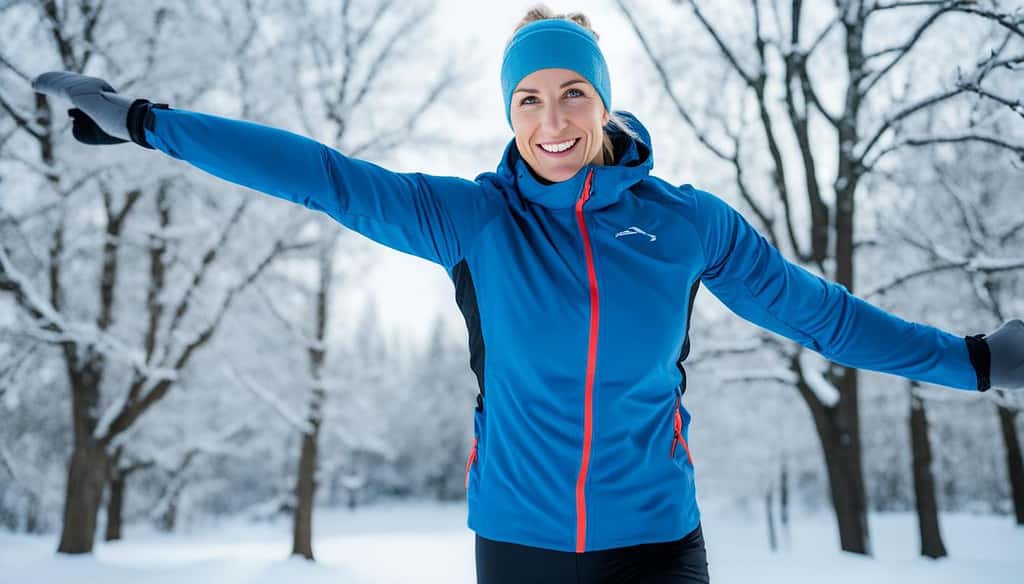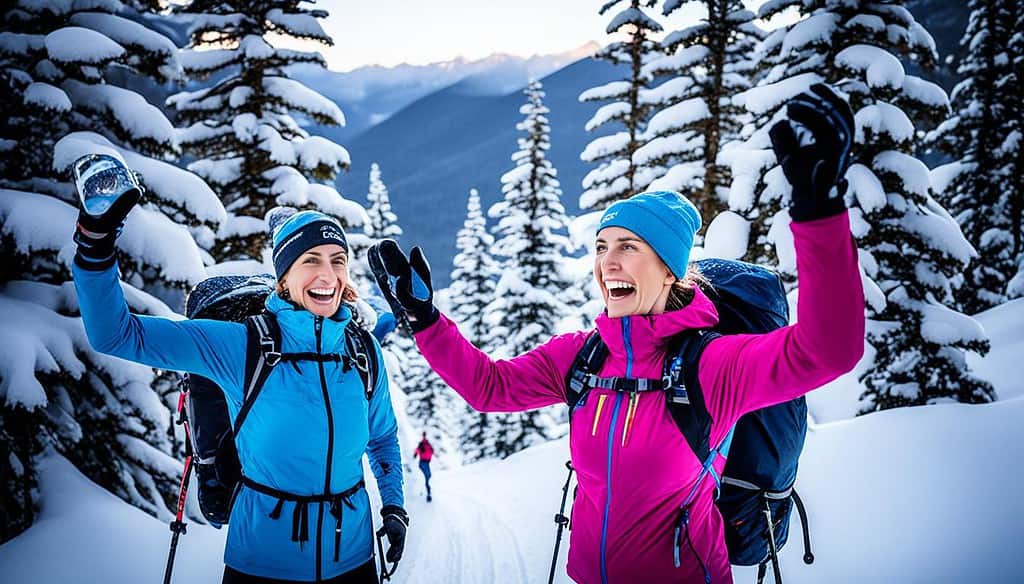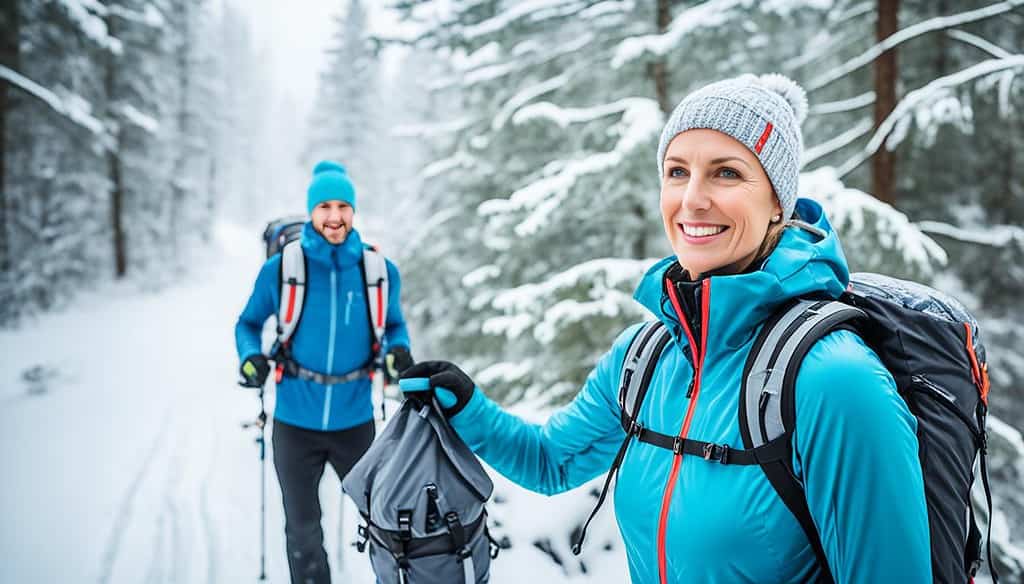Did you know that spending time outdoors in the cold can boost focus and creativity? Research shows that embracing winter exercise not only benefits the body but also enhances mental health. So, don’t let the low temperatures and snowflakes hold you back from staying active this winter!
Key Takeaways
- Winter workouts can help improve mood, energy levels, and weight management.
- Proper clothing, including moisture-wicking fabrics and layers, is essential for winter outdoor fitness.
- Extended warm-ups and hydration are crucial to prevent injuries and dehydration in cold weather.
- Exercising with a partner or group provides social support and motivation.
- Take advantage of natural light and plan ahead to make winter workouts more enjoyable and convenient.
The Importance of Proper Clothing
Proper clothing is crucial for winter outdoor fitness. When exercising in the cold, it’s important to dress ‘dry,’ not just ‘warm’. Wet clothing can quickly make you cold and increase the risk of hypothermia. To stay comfortable and protected, consider the following tips:
Dress for Moisture Management
Choose synthetic fabrics that wick away moisture from your body, keeping you dry and warm. Avoid cotton, as it retains moisture and can make you feel chilly.
Layer Up
Layering is essential for winter workouts. Start with a moisture-wicking base layer to keep sweat away from your skin. Add insulating mid-layers for warmth and protective outer layers to shield you from wind and moisture.
Opt for Bright Colors
Wearing bright-colored clothing and reflective gear improves your visibility, especially when exercising in low-light conditions.
Protect Your Extremities
Don’t forget to cover your extremities. Wear a hat to retain body heat and protect your head. Insulated gloves keep your hands warm, and properly fitting socks will keep your feet cozy.
Protect Your Skin
Even in winter, it’s important to protect your skin from harsh weather conditions. Apply moisturizer to prevent dryness and chapping. Don’t forget to apply sunscreen to exposed areas, as snow can reflect UV rays and increase the risk of sunburn.
Check Your Traction
Ensure you have proper traction on snowy or icy surfaces. Consider using traction cleats or winter shoes with good grip to prevent slips and falls.
“Proper clothing is the key to staying comfortable and safe during your winter outdoor workouts. Dressing ‘dry,’ layering up, and protecting your extremities and skin are essential for an enjoyable and injury-free experience.” – Fitness Expert
Remember, the right clothing can make a significant difference in your winter outdoor fitness routine, allowing you to stay warm, dry, and protected while enjoying the fresh air and reaping the benefits of exercise.
| Winter Clothing Tips | Benefits |
|---|---|
| Dress ‘dry,’ not just ‘warm’ | Prevents hypothermia and discomfort |
| Layer up | Regulates body temperature and provides versatility |
| Opt for bright colors and reflective gear | Enhances visibility and safety |
| Protect your extremities | Prevents heat loss and frostbite |
| Protect your skin | Prevents dryness, chapping, and sunburn |
| Check your traction | Reduces the risk of slips and falls |
Warm-Up and Cool-Down

In order to prevent injuries in cold weather, it is crucial to dedicate sufficient time to warm up before starting your winter outdoor workout. A longer warm-up is necessary to prepare your muscles and joints for the physical activity ahead.
One effective approach is to incorporate dynamic warm-ups that involve low-intensity movements. These movements increase blood flow, raise the body’s core temperature, and prepare the muscles for more intense exercise.
Here are a few examples of dynamic warm-up exercises to consider:
- Marching in place
- Arm circles
- High knees
- Leg swings
- Walking lunges
Performing these exercises for 5-10 minutes can help activate the major muscle groups and improve overall flexibility and mobility.
It’s important to note that stretching should be reserved for the cool-down phase, after completing your workout. Stretching cold muscles can increase the risk of injury. Instead, use the cool-down period to gradually bring your heart rate and breathing back to a resting state, and then perform static stretching exercises to help maintain flexibility.
| Benefits of Warm-Up | Precautions for Cool-Down |
|---|---|
|
|
Stay Hydrated
Even in cold weather, staying hydrated is important. People may not feel as thirsty during winter workouts, but dehydration can still occur. Drink up enough water to stay hydrated and prevent headaches and energy drops.
Find Exercise Partners or Groups

Exercising with a partner or group can be a game-changer when it comes to staying motivated and accountable during winter workouts. Not only does it provide social support, but it also adds an element of fun and excitement to your exercise routine. Whether it’s a running buddy, a cycling club, or a fitness class, seeking out an exercise partner or group can make a world of difference.
When you find a workout buddy or join a group, you’ll have someone to share the highs and lows of your fitness journey. They can offer encouragement, push you to go that extra mile, and be there to celebrate your achievements. Working out together creates a sense of camaraderie and a shared sense of purpose, making even the coldest winter days more enjoyable.
“Having a workout partner or joining a group has been a game-changer for me. It keeps me motivated, and I look forward to our workouts together. We encourage each other and have fun while staying active in the winter.”
Additionally, exercising with others can provide valuable opportunities for growth and learning. You can exchange ideas, learn new techniques, and discover different approaches to fitness. It’s a chance to broaden your horizons and challenge yourself in ways you may not have thought possible.
So, how can you find exercise partners or groups? Consider joining local fitness clubs, community centers, or sports leagues. Look for online fitness communities or join social media groups that align with your interests. Participate in fitness events or group workouts organized by local gyms or fitness studios. By putting yourself out there, you’ll increase your chances of finding like-minded individuals who share your passion for winter outdoor fitness.
Remember, seek out an exercise partner or group that aligns with your goals, interests, and fitness level. It’s essential to find a supportive community where you feel comfortable and motivated to challenge yourself.
Benefits of Exercising with a Partner or Group:
- Increased motivation and accountability
- Social support and companionship
- Opportunity for learning and growth
- Enhanced enjoyment and fun during workouts
So, don’t let the winter weather deter you from staying active. Seek out an exercise partner or group and embark on a fitness journey together!
Take Advantage of Natural Light

Lack of natural light can be a demotivating factor in winter. However, there are ways to combat this and make the most of daylight to boost your motivation and overall well-being.
Enlist the Thermostat in Your Cause:
Adjusting the thermostat in the morning can create a comfortable environment for exercise. By setting the temperature to a cozy level, you’ll feel more inclined to get moving and take advantage of the natural light outside.
Exercise during Your Lunch Break:
Instead of spending your entire lunch break indoors, consider going outside for a quick workout. Take a brisk walk or jog to soak up the natural light and fresh air. Not only will this energize your body, but it can also provide a much-needed mental boost for the rest of the day.
Focus on the Mental Health Benefits:
When motivation is low, it can be helpful to remind yourself of the mental health benefits of exercise. Physical activity releases endorphins, which can reduce stress, boost mood, and improve overall mental well-being. By focusing on these positive effects, you’ll find the motivation to prioritize your fitness routine, even during the winter months.
Benefits of Exercising in Natural Light:
| Benefits | Description |
|---|---|
| Improved Mood | Exposure to natural light helps regulate serotonin levels, promoting feelings of happiness and well-being. |
| Boosted Vitamin D | Natural light is a primary source of vitamin D, which is vital for bone health, immune function, and mood regulation. |
| Increased Energy | Natural light stimulates the production of cortisol, making you feel more alert and energetic. |
| Better Focus and Productivity | Exposure to natural light can enhance concentration, attention, and overall cognitive performance. |
| Regulated Sleep Patterns | Exposure to natural light helps regulate the body’s internal clock, leading to improved sleep quality. |
So, don’t let the lack of natural light deter you from staying active during winter. Use the strategies mentioned above to enlist the thermostat in your cause, exercise during your lunch break, and focus on the mental health benefits of outdoor workouts. Embrace the natural light, and you’ll find yourself reaping the rewards of a healthier body and a clearer mind.
Plan Ahead and Be Prepared

When it comes to winter outdoor workouts, planning ahead and being prepared can make a world of difference. By taking a proactive approach, you can ensure that you’re ready to tackle your fitness goals no matter the weather. Here are some essential tips to help you stay on track:
Check the Weather Forecast
Before heading out for your exercise session, it’s crucial to check the weather forecast. This will allow you to anticipate any changes in temperature, precipitation, or strong winds. Armed with this information, you can make informed decisions about what type of workout to do and what gear to wear.
Prepare Your Gear in Advance
Another key aspect of planning ahead is preparing your workout gear in advance. Lay out your exercise clothes, including layers, hats, gloves, and socks, the night before. This way, when you come home from work, you can easily transition into your workout attire and eliminate any excuses. You can also opt to sleep in your exercise clothes to streamline your morning routine – just be sure they’re comfortable enough for a good night’s sleep.
| Benefits of Preparing Your Gear in Advance: |
|---|
| 1. Saves time in the morning |
| 2. Removes barriers to getting started |
| 3. Increases commitment to your workout |
Stay Organized
Keeping your workout gear organized is essential for a smooth and hassle-free experience. Designate a specific area in your home where you can store your winter exercise clothes and equipment. This will help you easily locate what you need and prevent any last-minute scrambling.
Plan ahead and anticipate the challenges that winter may bring. By putting on your exercise clothes when you come home from work or even sleeping in them, you’re setting yourself up for success.
Be Flexible
Even with careful planning, weather conditions can change unexpectedly. It’s important to have alternative workout options in place so that you can adapt your routine accordingly. This could mean having a backup indoor workout plan or being open to trying different activities that can still provide a challenging workout.
By planning ahead, preparing your gear in advance, and staying organized, you’ll be well-prepared to tackle your winter workouts. Don’t let the cold weather stand in your way – with the right mindset and preparation, you can achieve your fitness goals all year round.
Running in Winter
When it comes to maintaining an active lifestyle during the winter season, running is a popular choice for many fitness enthusiasts. However, running in colder temperatures requires some extra preparations and precautions to ensure a safe and enjoyable experience. In this section, I will cover the essential tips for running in winter, including getting the right gear, stretching it out, and running smart.
Get the Right Gear
One of the most critical aspects of running in winter is having the right gear to keep you warm and comfortable. Here are some gear essentials:
- Moisture-wicking clothing: Opt for thermal layers that can effectively manage sweat and keep you dry throughout your run.
- Hats and gloves: Protect your extremities from the cold by wearing insulated hats and gloves.
- Cold-weather running shoes: Invest in shoes designed specifically for colder temperatures to provide better traction and insulation.
Stretch It Out
Before hitting the pavement, it’s crucial to warm up your body and prepare your muscles for the run. A dynamic warm-up routine will increase your heart rate, improve circulation, and reduce the risk of injury. Some effective warm-up exercises include:
- Arm and leg swings
- High knees
- Walking lunges
- Butt kicks
Running Smart
“In the midst of the chill, running in winter can be invigorating and refreshing. But it’s essential to listen to your body and take the necessary precautions.”
When running in winter, it’s crucial to listen to your body and adjust your pace and intensity accordingly. Here are some smart running tips to keep in mind:
- Start slow: Ease into your winter running routine and gradually increase your distance and intensity over time.
- Pay attention to your knees and hips: Running on potentially slippery surfaces in winter can put extra strain on your joints. Be mindful of your form and avoid sudden movements.
- Stay hydrated: Even though you may not feel as thirsty during cold weather, staying hydrated is still essential for optimal performance.
By following these tips, you can make the most of your winter running sessions while staying safe and comfortable. Remember, the winter season provides a unique opportunity to explore new running routes and enjoy the crisp, refreshing air.
Hiking in Winter
When it comes to hiking in winter, it’s important to start slow and have a plan. The cold weather and potential hazards require extra caution and preparation to ensure a safe and enjoyable hiking experience. Here are some tips to keep in mind:
- Choose appropriate routes: Opt for trails that are suitable for winter conditions and match your hiking skill level. Start with shorter, easier hikes and gradually progress to more challenging ones as you gain experience.
- Invest in the right footwear: The right footwear is essential for comfort and safety during winter hikes. Invest in waterproof hiking boots that provide insulation and support. Consider adding crampons or traction devices for added grip on icy surfaces.
- Layer up: Dress in layers to regulate your body temperature. Start with a moisture-wicking base layer to keep sweat away from your skin. Add insulating mid-layers for warmth and a protective outer layer to shield against wind, rain, and snow.
- Stay hydrated and nourished: Despite the cold weather, it’s crucial to stay hydrated during your hike. Carry an insulated water bottle and drink regularly. Pack snacks that provide energy and nutrition to fuel your body.
- Be prepared for changing weather: Winter weather can be unpredictable. Pack essential items such as a map, compass, flashlight, extra clothing, and emergency supplies in case the weather worsens or you encounter any unexpected challenges.
Remember to check weather conditions before heading out and let someone know your hiking plans. It’s also a good idea to hike with a partner or in a group for added safety and enjoyment. Now, lace up your boots, plan your route, and embark on a winter hiking adventure!
Tip: Stay Mindful of Hypothermia
Hypothermia is a serious risk when hiking in cold conditions. Make sure to recognize the symptoms, such as shivering, confusion, and lack of coordination. If you or anyone in your group experiences these symptoms, seek shelter, change into dry clothing, and warm up gradually. In severe cases, seek immediate medical attention.
Cycling in Winter
When it comes to cycling in winter, there are a few key considerations to keep in mind for a safe and enjoyable ride. Here are some tips to help you make the most of your winter cycling adventures:
- Consider Clear Roads: Before heading out, check the road conditions and choose routes that have been cleared of snow and ice. Safety should always be a top priority.
- Incorporate Dynamic Stretching: Dynamic stretching before your ride is important to warm up your body and prepare it for the activity. Focus on stretching your muscles in the knees, hips, and lower back to promote flexibility and prevent injuries.
- Start Slow: It’s essential to ease into your winter cycling routine. Begin with shorter, less intense rides to allow your body to adjust to the colder temperatures. Gradually increase your distance and intensity over time.
- Knees, Hips, and Shoes: Protect your knees and hips by maintaining proper form while cycling. Ensure that your bike is properly fitted to your body proportions and adjust the seat height to prevent discomfort and potential joint pain. Also, wear appropriate shoes that provide warmth, support, and traction.
Remember, winter cycling can be a unique and invigorating experience, but it’s important to prioritize safety and listen to your body’s needs. By considering road conditions, incorporating dynamic stretching, starting slow, and taking care of your knees, hips, and shoes, you can enjoy the benefits of cycling while embracing the beauty of the winter season.
“Winter cycling can be a unique and invigorating experience, but it’s important to prioritize safety and listen to your body’s needs.”
Other Winter Outdoor Activities
Aside from running, hiking, and cycling, there are two other popular winter outdoor activities that provide both cardiovascular exercise and enjoyment: cross-country skiing and ice skating. These activities offer unique ways to stay active in the cold while embracing the winter wonderland.
Cross-country skiing is a fantastic full-body workout that engages your arms, legs, and core muscles. It is a low-impact exercise that can improve cardiovascular endurance and strengthen your muscles. To get the most out of your cross-country skiing experience, it’s essential to learn the proper technique and form. Taking lessons or seeking guidance from experienced skiers can help you master the skills needed to glide smoothly and efficiently on the snow-covered trails.
Ice skating is not only a recreational pastime but also an excellent way to stay fit during the winter months. It engages your lower body muscles, particularly the glutes, quadriceps, and calves, while also improving balance and coordination. Whether you prefer figure skating or speed skating, ice skating offers cardiovascular benefits while having fun on the ice rink. It’s important to warm up before lacing up your skates and to wear appropriate protective gear, such as helmets and padding, especially for more aggressive skating styles.
| Activity | Benefits | Considerations |
|---|---|---|
| Cross-country skiing |
|
|
| Ice skating |
|
|
So whether you decide to glide through the snowy landscapes on cross-country skis or gracefully twirl around an ice rink, these winter activities offer a unique blend of exercise and enjoyment. Just remember to prioritize safety, warm up properly, and dress in appropriate attire.
Conclusion
Embracing winter outdoor fitness can provide numerous benefits for both physical and mental health. The crisp, fresh air invigorates the senses and adds a refreshing element to your exercise routine. Not only does it help improve your cardiovascular fitness and maintain weight management, but spending time outside in the cold can also have a positive impact on your mental well-being.
Research suggests that being in natural surroundings during winter boosts focus, creativity, and overall mood. It’s a great way to combat the winter blues and enhance your motivation to stay active. By layering up with appropriate clothing to stay dry and warm, you can fully enjoy the winter wonderland while keeping your extremities protected.
Remember, it’s crucial to warm up properly before starting your outdoor workout to prevent injuries. And even though you may not feel as thirsty during cold weather, staying hydrated is just as important. Don’t forget to drink enough water to keep your body functioning optimally.
So, whether it’s finding exercise partners or groups for added support and camaraderie, taking advantage of natural light to boost your mood, or planning ahead to remove obstacles to your fitness routine, there are plenty of ways to stay motivated and prioritize your well-being during winter. With the right mindset, preparation, and clothing choices, you can embrace the benefits of winter outdoor fitness and enjoy a rewarding and invigorating exercise experience.
FAQ
How can I stay fit during the winter?
Embracing winter outdoor fitness can provide numerous benefits for physical and mental health. With the right clothing, preparation, and mindset, staying active in the cold can be enjoyable and rewarding.
What should I wear for winter workouts?
Dress ‘dry,’ not just ‘warm.’ Layer up with moisture-wicking base layers, insulating mid-layers, and protective outer layers. Opt for bright colors and wear reflective gear for visibility. Protect your extremities with hats, gloves, and insulated socks. Apply moisturizer and sunscreen to protect your skin. Use traction cleats for traction on snowy or icy surfaces.
How important is warming up and cooling down during winter workouts?
Do a warm-up first. Cold weather requires a longer warm-up to prevent injuries. Dynamic warm-ups that include low-intensity movements are recommended. Save stretching for the cool-down after the workout.
Is staying hydrated important during winter workouts?
Yes, staying hydrated is important even in cold weather. Drink enough water to stay hydrated and prevent headaches and energy drops. People may not feel as thirsty during winter workouts, but dehydration can still occur.
Should I exercise alone or with others during winter?
It is beneficial to find exercise partners or groups. Exercising with others provides social support, motivation, and accountability. It can help overcome the challenges of winter and make workouts more enjoyable.
How can I make the most of natural light during winter?
Enlist the thermostat in your cause by adjusting it in the morning to create a comfortable environment for exercise. Take advantage of daylight during your lunch breaks for a mood boost and fresh air. Focus on the mental health benefits of exercise to stay motivated.
How can I plan ahead for winter outdoor workouts?
Plan ahead and anticipate by checking weather forecasts and preparing workout gear in advance. Remove barriers to getting started by putting on exercise clothes after work or even sleeping in them.
What do I need for running in winter?
To run in winter, get the right gear, such as moisture-wicking clothing, hats, gloves, and shoes suitable for colder temperatures. Stretch it out with dynamic warm-ups before running. Consider proper form and training levels, especially for new runners.
What should I consider when hiking in winter?
Start slow and have a plan when hiking in winter. Choose appropriate routes and be mindful of the weather conditions. The right footwear, including waterproof shoes, is essential for comfort and safety.
How can I cycle in winter?
Consider road conditions and stick to cleared paths when cycling in winter. Incorporate dynamic stretching into your warm-up routine. Start with shorter, less intense rides and adjust your seat height for proper bike fit. Take care of your knees, hips, and shoes to prevent pain.
What are some other winter outdoor activities to try?
Cross-country skiing and ice skating are popular winter activities that provide both cardio and enjoyment. Each activity requires proper form, warm-up, and appropriate gear for safety.
What are the benefits of winter outdoor fitness?
Winter outdoor workouts can help improve mood, energy levels, and weight management. Spending time outdoors in the cold can boost focus and creativity. Research shows that spending time outside improves mental health.
Source Links
- https://www.everydayhealth.com/healthy-living/fitness/easy-winter-exercise-tips-help-you-stay-fit/
- https://health.clevelandclinic.org/how-to-stay-active-outside-when-the-weather-gets-colder
- https://www.today.com/series/one-small-thing/how-stay-active-winter-11-winter-workout-tips-exercising-cold-t169615
As a veteran fitness technology innovator and the founder of GearUpToFit.com, Alex Papaioannou stands at the intersection of health science and artificial intelligence. With over a decade of specialized experience in digital wellness solutions, he’s transforming how people approach their fitness journey through data-driven methodologies.
